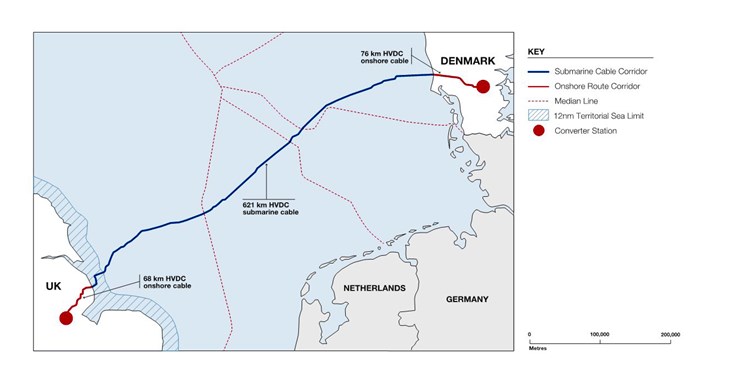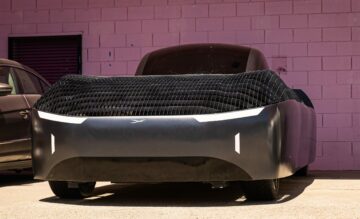Sign up for daily news updates from CleanTechnica on email. Or follow us on Google News!
The world’s longest electricity cable connection, Viking Link, began pushing electrons from Denmark directly to the UK last week. The DKK 13 billion ($1.92 billion) investment has been almost 4 years in the making and is the first physical connection between the two otherwise completely separate energy systems. Viking Link enables even more renewable energy to be produced and balanced over a very large geographical region of northern Europe.

The Danish system operator Energinet has built the 765 km (475 mile) long electricity connection between Denmark and Great Britain together with its partner, the UK’s National Grid, and on the 29th of December in the afternoon the first power from Danish wind turbines was sent out to English consumers. Over such long distances, only High Voltage Direct Current (HVDC) is possible. Power is converted onshore to AC.
Thomas Egebo, CEO of Energinet, said, “Creating an electricity connection between Denmark and England is in itself a huge achievement — Viking Link is actually the world’s longest cable connection. But the connection is also of great importance for the completely green electricity system of the future. We ensure that the green electrons from wind turbines and solar cells can be managed and sent the consumers’ sockets, in a stable and affordable fashion.”
Denmark already has high capacity electricity connections to Norway, Sweden, Germany, and the Netherlands, and with this additional connection to a neighboring country, Danish producers can sell and export electricity to an even greater extent when the wind is blowing and the sun is shining. Conversely, Denmark can now also buy electricity when there is plenty on the other side of the North Sea — for example when a wind front from the west hits Great Britain a day before it hits Denmark, and then when the wind front hits the Danish wind turbines, the excess energy can be sent back.
In this part of Europe, the wind coming from the west is a stable and recurring pattern, so this cable makes it possible to level out the inherent intermittency of wind power to a significant degree. I think this is a big deal, and the data in the coming years will show what works and what doesn’t. Some will argue this project is very expensive and why not build nuclear power in Denmark? Well, I don’t think there is any comparison in this particular case, in that a couple of billion dollars won’t get you much nuclear power, not even factoring in the very long timelines of commissioning and decommissioning. However, IEA does maintain the view that nuclear power still plays an important role in the overall low emission goals.
In conjunction with the 1,600 MW cable from Denmark to Norway, and multiple high power connections to Sweden and Germany, the layout for energy arbitrage in the region has become much more interesting now. However, for the time being, the new cable will only be utilized up to 800 MW of its total capacity of 1,400 MW. When more wind turbines have come online in the region in 2025, it will be dialed up.
Have a tip for CleanTechnica? Want to advertise? Want to suggest a guest for our CleanTech Talk podcast? Contact us here.
Our Latest EVObsession Video
[embedded content]
I don’t like paywalls. You don’t like paywalls. Who likes paywalls? Here at CleanTechnica, we implemented a limited paywall for a while, but it always felt wrong — and it was always tough to decide what we should put behind there. In theory, your most exclusive and best content goes behind a paywall. But then fewer people read it!! So, we’ve decided to completely nix paywalls here at CleanTechnica. But…
Thank you!
Advertisement
CleanTechnica uses affiliate links. See our policy here.
- SEO Powered Content & PR Distribution. Get Amplified Today.
- PlatoData.Network Vertical Generative Ai. Empower Yourself. Access Here.
- PlatoAiStream. Web3 Intelligence. Knowledge Amplified. Access Here.
- PlatoESG. Carbon, CleanTech, Energy, Environment, Solar, Waste Management. Access Here.
- PlatoHealth. Biotech and Clinical Trials Intelligence. Access Here.
- Source: https://cleantechnica.com/2024/01/01/viking-link-worlds-longest-hvdc-cable-connecting-uk-scandinavia-now-online/
- :has
- :is
- :not
- $UP
- 1
- 13
- 15%
- 2025
- 36
- 400
- 600 MW
- a
- AC
- achievement
- actually
- Additional
- Advertise
- Affiliate
- affordable
- almost
- already
- also
- always
- an
- and
- any
- arbitrage
- argue
- At
- back
- balanced
- BE
- become
- been
- before
- began
- behind
- being
- BEST
- between
- Big
- Billion
- Bit
- Blowing
- britain
- build
- built
- but
- buy
- cable
- CAN
- Capacity
- case
- Cells
- ceo
- chip
- cleantech
- Cleantech Talk
- come
- coming
- coming years
- Companies
- comparison
- completely
- conjunction
- Connecting
- connection
- Connections
- Consumers
- content
- conversely
- converted
- country
- Couple
- Current
- danish
- data
- day
- deal
- December
- decide
- decided
- Degree
- Denmark
- direct
- directly
- does
- Doesn’t
- dollars
- don
- Dont
- electricity
- electrons
- embedded
- emission
- enables
- energy
- England
- English
- ensure
- Europe
- Even
- example
- excess
- Exclusive
- expensive
- export
- extent
- factoring
- Fashion
- felt
- fewer
- First
- For
- from
- front
- future
- geographical
- Germany
- get
- Goals
- Goes
- great
- Great Britain
- greater
- Green
- Guest
- Have
- help
- here
- High
- Hits
- However
- HTTPS
- huge
- i
- IEA
- if
- implemented
- importance
- important
- in
- inherent
- interesting
- investment
- IT
- ITS
- itself
- jpg
- large
- Last
- latest
- Layout
- Level
- like
- likes
- Limited
- LINK
- links
- Long
- Low
- maintain
- MAKES
- Making
- managed
- max-width
- Media
- more
- most
- much
- multiple
- Need
- neighboring
- Netherlands
- New
- news
- North
- North Sea
- Norway
- now
- nuclear
- Nuclear power
- of
- on
- online
- only
- operator
- or
- Other
- otherwise
- our
- out
- over
- overall
- part
- particular
- partner
- Pattern
- People
- physical
- plato
- Plato Data Intelligence
- PlatoData
- player
- plays
- Plenty
- podcast
- policy
- possible
- power
- Produced
- Producers
- project
- publish
- Pushing
- put
- Read
- Reader
- recurring
- region
- Renewable
- renewable energy
- Role
- s
- Said
- SEA
- see
- sell
- sent
- separate
- should
- show
- side
- significant
- So
- solar
- Solar cells
- some
- stable
- Still
- Stories
- such
- suggest
- Sun
- support
- Sweden
- system
- Systems
- T
- Talk
- team
- that
- The
- The Future
- the Netherlands
- the UK
- The West
- then
- theory
- There.
- Think
- this
- time
- timelines
- tip
- to
- together
- Total
- tough
- two
- Uk
- Updates
- us
- uses
- utilized
- Ve
- very
- Video
- Voltage
- want
- was
- we
- week
- WELL
- West
- What
- when
- while
- WHO
- why
- will
- wind
- wind power
- with
- works
- world
- world’s
- write
- Wrong
- years
- you
- Your
- youtube
- zephyrnet






